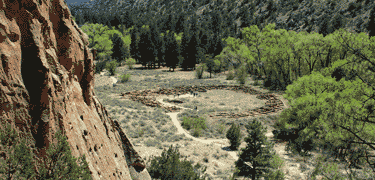
Glad to see that Bandelier is back open!
“The prehistoric Native American archaeological sites that fill the heart of northern New Mexico's Bandelier National Monument have reopened to visitors, three months after the largest wildfire in the state's recorded history sent employees scrambling to save rare artifacts and irreplaceable artwork.
The monument's visitor center and biggest concentration of prehistoric cultural sites survived the fire and a second threat – post-fire flooding that sent ash, sediment and charred debris into the heart of the monument.
But the hazardous conditions kept the sites off-limits for weeks, until employees began welcoming shuttle buses of visitors back to the canyon Monday.
“It's great to have people back in the park,” said Rod Torrez, Bandelier's chief of interpretation, who was among the park officials there when the first bus pulled up. “I was expecting it to be quiet this first week, but people have been waiting a long time to get here.”
The first bus arrived with 18 passengers, including Dan and Mary Lee of Traverse City, Michigan. The couple was in New Mexico celebrating their 50th anniversary. They decided to extend their trip by a day to see the sights at Frijoles Canyon, including the kivas dug into the canyon floor for ceremonies, the stone pueblo walls that surround them, the wildflowers that have overtaken the area and the dwellings carved by the ancestors of modern Native Americans into the canyon walls.
“We're really lucky,” said Mary Lee, who was ready for the short hike through the canyon with her backpack, hat and hiking poles. “This is the purpose of our trip, to visit prehistoric Indian sites.”
Every bus after the first was filled to capacity with dozens of visitors waiting their turn for the next hike. The visitors came from California, Oregon, Pennsylvania, Florida and even Germany.
This marks one of the busiest times of year for Bandelier, which sees about 238,000 visitors annually. Parks officials said they wanted to open the canyon given the upcoming annual balloon fiesta in Albuquerque is expected to draw thousands of tourists to the state.
Park Superintendent Jason Lott said he won't mind being busy.
“That's the business we're supposed to be in,” he said. “It's resource management, and it's visitor experience. It's been closed for three months, and it's not healthy for the resource, it's not healthy for the staff, and it's not healthy for the visitors for us not to be doing this.”
The buses will run seven days a week through October.
By November, Lott said tourist season should be waning and the park plans to open the canyon so visitors can once again make the drive down the scenic canyon on their own. More trails are also expected to reopen later this fall.
Park officials said they have eagerly awaited the day visitors could again enjoy what is undoubtedly the most popular area of the sprawling park.
Tucked into northern New Mexico's ancient canyons, Bandelier has a long human history that stretches back more than 10,000 years. Aside from Native Americans, Spanish settlers and the Civilian Conservation Corp centuries later also left their mark on the area.
Nearly two-thirds of the monument was scorched during the Las Conchas fire, which started June 26 after a tree fell on a power line miles (kilometers) away. The flames raced across mesa tops and down canyons dotted with hundreds of archaeological sites.
The monument's employees were left scrambling that afternoon to save pieces of prehistoric pottery, rare artifacts and more modern-day Native American artwork. They used blankets, old uniforms and even the American flag to wrap the pieces to be transported out of the canyon to safety.
The fire stopped a mile (1.6 kilometer) from the monument's largest concentration of prehistoric cultural sites. Also spared were a collection of historic buildings constructed by workers during the New Deal and the newly renovated $3.2 million visitor center.
The blaze destroyed more than five dozen homes in the surrounding mountains and threatened one of the nation's premier nuclear weapons laboratories in Los Alamos. Since then, the whole region has been struggling to recover.
The threat over the past several weeks had been summer rains pounding down on the massive burn scar.
Thunderstorms in late August resulted in some flooding at Bandelier. Some of the concrete barriers and sandbags along Frijoles Creek near the visitor center were wiped out, as were parts of a hiking trail downstream. Workers spent days removing debris along the creek.
No major damage to the visitor center was apparent aside from a muddy water line at the edge closest to the creek.
The archaeological sites, administration building and gift shop escaped unscathed because they are on higher ground.
Still, questions remain about the long-term ecological impacts of the fire and its effects on the park. Visitors on Monday questioned rangers throughout the canyon about the fire, the flooding and the aftermath.
The 244-square-mile (632-square-kilometer)blaze reduced entire mountainsides and canyons to nothing but ash and blackened tree trunks. Thousands of fallen trees were vaporized.
All but 1,000 acres (405 hectares) of the 12,000-acre (4,856-hectare)upper Frijoles watershed burned, and officials said most of the burning was severe, leaving no vegetation behind.
Since Bandelier will continue to be at the mercy of Mother Nature, park officials said they decided to limit visitor activity in the canyon to assure safety.
I don't think we'll get back to normal for another two years, assuming we don't have any additional fires next summer,” Lott said. “And monsoon season will continue to impact our operations, and until the ecosystem and the landscape stabilizes, we're going to have to do things that are not normal to protect resources and visitors.”
Read more http://www.nativetimes.com/life/travel/6094-new-mexico-monument-reopens-archaeological-sites
Photo from http://www.nps.gov/band/index.htm


















































